









Specification Motorcycles New 2009 Satria FU 150cc Sport Edition
MACHINE
Type: 4-No, DOHC, Air Berpendingin SACS, 4-valve
Number of Cylinders: 1 (one)
Cylinder diameter: 62.0 mm
Step Piston: 48.8 mm
Fill cylinder: 147 cc
Comparison Compression: 10.2: 1
Maximum power: 11.7 ps / 9500 rpm
Maximum torque rpm 12.4 Kgm/8500
Carburetor: Mikuni BS 26-187
Air Filter: Paper Type
Starter System: Foot & Power
Lubrication system: Soaking Oli
DIMENSIONS & WEIGHT
Overall length: 1945 mm
Overall Width: 650 mm
Height overall: 980 mm
As the distance between wheels: 1280 mm
Distance Machine To Land: 140 mm
Sitting high place: 764 mm
Empty weight: 106 kg
FRAMEWORK
Suspension Front: Teleskopik, bearings Oli
Rear Suspension: Sway Arm, bearings Oli
Rudder angle: 45 ° (left and right)
Turn Radius: 2.0 m
Brakes Front: Disc
Rear brake: Disc
Front Wheel Size: 70/90 – 17 38P
Rear Wheel Size: 80/90 – 17 44P
Electricity
Ignition system: CDI
Spark plug: NGK DENSO CR8E or U24ESR-N
Accu: 12V 2.5 Ah 10 HR
CAPACITY
Fuel tank: 4.9 Liter
Engine oil: 1,000 ml
With oil filter replacement: 1100 ml
TRANSMISSION
Clutch: Manual type wet multiple plates
Transmission: 6 Acceleration
The displacement direction Teeth: 1 down, 5 to top




 Suzuki Satria Fu Like Italian Sport Bikes Modifications
Suzuki Satria Fu Like Italian Sport Bikes Modifications


It really is a well-produced series that goes deep behind the scenes to show the viewers the real tensions that racers and teams face every week.
Check out all six videos below the jump.ATV-24/7 Act 1: Meet the racers from ATV-24/7 on Vimeo.
ATV 24/7: EPISODE 2 (full episode) from ATV-24/7 on Vimeo.
ATV-24/7: Episode 3 (full episode) from ATV-24/7 on Vimeo.
ATV 24/7 Episode 4 - Full Episode from ATV-24/7 on Vimeo.
ATV-24/7: Episode 5 (FULL SHOW) from ATV-24/7 on Vimeo.
ATV 24/7, Episode 6 (Full Episode) from ATV-24/7 on Vimeo.
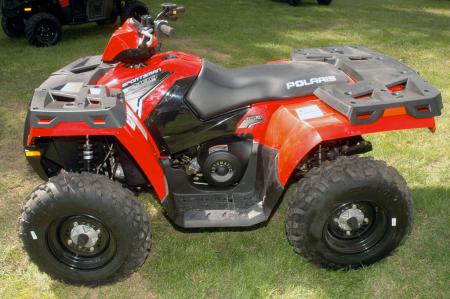
Engine/Drivetrain
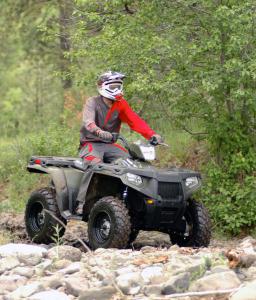
The hearty High Output 455cc single-cylinder four-stroke engine was carried over from the old Sportsman 400. The liquid-cooled mill is fed via a carburetor and is mated to a reworked Polaris Variable Transmission. The continuously variable transmission went under the microscope and was improved to be more efficient. Buyers will appreciate the addition of low range, which improves its abilities in working situations and gives the engine more heart in difficult terrain (rocks, mud, etc.). Polaris said small changes to the CVT led to a quieter operation, too.
The engine should also run cooler as the radiator was moved upward three inches and is now angled to the rear. This small change, said Polaris, reduces the amount of mud on the radiator. Shaft drive moves the rear wheels for simple two-wheel drive performance. Four-wheel drive — Polaris calls it an all-wheel drive system (AWD) — mode is engaged via a switch on the right side of the handlebar. It’s an easy-to-use setup and proven to be very popular. Engine braking (available as an accessory) and hill descent control are not standard on the 400.
Chassis/Suspension
The biggest change for the Sportsman 400, year to year, was to its frame. The 2011 model now features a full-size chassis, borrowed from the 500 H.O. That also means it added extra weight (688-lb. dry weight). A closer look at the front of the chassis will also reveal a new placement for the integrated winch mount. You’ll get greater pulling force with the reduced winch height.
The “Value” Sportsman quads (800/500/400) each use MacPherson Struts with the front suspension design as opposed to a double A-arm setup with shocks. Up front, the struts supply a pleasant 8.2 inches of travel. On the rear, Polaris added its proven fully Independent Rear Suspension with dual A-arms and two shocks that supply 9.5 inches of travel. Combine the plush suspension with a huge 11.25 inches of ground clearance and the Sportsman 400 H.O. is very capable in rugged terrain.
Ergonomics/Miscellaneous
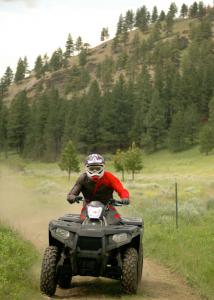
Being that this ATV is now a full-size 4x4, it’s far more comfortable for bigger (taller and heavier) riders. It’s not like the previous 400 version was overly small, but the new configuration is more appealing to a wider spectrum of buyers, at least in our opinion. Even with its new size, the Sportsman 400 has a respectable 33.75-inch seat height, which keeps it rather low to the ground. Combine that stat with its 48-inch width and 50.5-inch wheelbase, and it’s clear why the machine is so stable. Also, Polaris said the front rack was moved back 3.5 inches and narrowed for a more streamlined look and reconfigured to accept its Lock & Ride accessories.
Ride Report
The 2011 Sportsman 400 H.O. is what it is. That’s not a knock on the machine; it’s a simple fact. It’s meant to be a budget friendly 4x4 with middle-of-the-road performance. If you need more power and capabilities, you can go larger in this budget family (500 or 800) or explore the XP line of Polaris ATVs. However, with that said, the new 400 H.O. is superior when compared to last year’s unit. This ’11 400 instantly shouts SPORTSMAN, where as the previous model gave off a weaker, less formidable Sportsman persona — and was seen as THE OTHER Sportsman, if you will.
In terms of engine performance, the 455cc four-stroke has more work to do in the new chassis (which gained 90 pounds from a year ago). However, it proved more than capable during our testing in Montana. It’s not super quick or overly fast, but Polaris is OK with that and so are we. Why? We get it; it’s a mid-level quad with good power.
We will say the addition of low range was huge. No longer do you need to worry about powering through the slop or up challenging rocky trails and trying to find the appropriate throttle control and torque in high range. Low range simplifies this type of riding situation and certainly makes working with the 400 H.O. more appealing, too. It’s also needed because engine braking is only available as an accessory on the 400. For hill descents, we used low gear, skilled braking and appropriate body positioning.
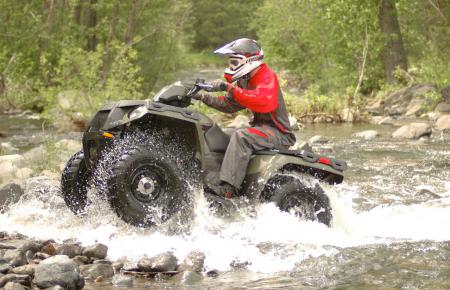 |
A few deeper creek crossings, with hidden holes and large, moss-covered rocks were an ideal test for this ATV and its 4x4 system. We had no concerns or issues while riding the 400 in this section of the test trail. Although the Sportsman could tame the waterway in high range, we opted for low for more torque and precision throttle control. The new Sportsman also did well keeping us dry in the water sections. The floorboards offered full foot and leg protection, but also drained well and the foot pegs are just aggressive enough to keep a hold of wet-soled boots. We crossed a few of the streams at a quicker pace and were pleased with how well the fenders kept us dry.
We also tested this quad’s overall speed on a few two-track roads and felt happy with its ability to entertain. We’d still like to see it called a Sportsman 450 — because that’s what it is — but understand the 400-class name offers more space between the 500 model and lets it appeal to both 400cc and 450cc buyers. While we adore the Sportsman XP model’s front suspension, we think the MacPherson strut front suspension has its place in the market and is a good fit for a machine of the 400’s caliber and value. When pushed hard over rough terrain or around corners, the front end bounced down the trail and caved a bit, but it never got out of control. In fact, the front suspension and IRS do a great job of smoothing out ruts and unforeseen, square-edged hits.
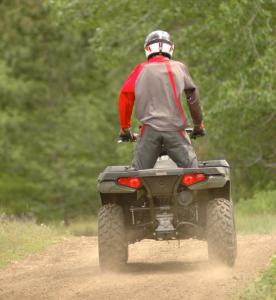
For the 2011 400 H.O., comfort and ergonomics are its biggest selling features (sans the new price). Measuring 6-foot tall and weighing 200 pounds, we were very comfortable on the quad. We feel it will fit a wide assortment of riders of various sizes and experience levels. The CVT and single-lever braking (though we appreciate separate controls) make it easy to ride — just gas and go! Combine that simple platform with its accommodating size, supple seat and sofa-like ride and it’s easy to see why so many buyers love their Sportsman ATV. And now Sportsman 400 owners can truly appreciate what their Sportsman 500 owners have known for ages.
The 400 also carries on the Sportsman family tradition with full floorboards, headlight pod, Lock & Ride convenience, automotive-like transmission lever, unique riding posture and large, thumb throttle and housing.
Better Off
Polaris already tried the mid-size route with its old Sportsman 400 and the end result was a good machine that felt too small and somewhat odd when compared to its full-size Sportsman brothers. It just didn’t seem to represent the family name. Well, now it does.
The 2011 Sportsman 400 H.O. is far more impressive, roomier and comfortable than its predecessor. Not only can it work harder, thanks to low gear and improved rack capacities, it can also entertain a wider variety of riders with its big-bore-like size and attributes. Better suspension performance and 25-inch tires are an added bonus. Toss all those upgrades in a bowl and throw in an even more affordable price and you have recipe for success, Sportsman style!
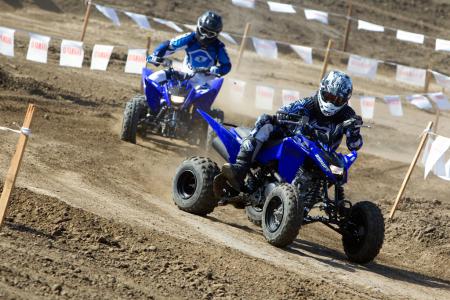
The Raptor 125 was designed to be the perfect machine to make the transition from moving up from a 90cc ATV. Yamaha felt that the jump from 90cc to 250cc was significant and decided to do what no other major manufacturer had tried – build a true entry-level sport quad. Not only did Yamaha design the Raptor 125 for those wanting to make an easier transition from a 90cc machine, Yamaha also noticed that the majority of the ATV’s in the range of 90cc-250cc were being built with questionable quality by off-shore companies.
While there are some import ATVs that have good parts availability, often times it’s difficult to find parts if and when something breaks. If a part does break on one of these imports the consumer may be stuck with little more than a push toy. Yamaha wanted to make a product for this segment that not only has the quality we’ve come to expect from a major manufacturer, but also the dealer network and parts availability the consumer needs.
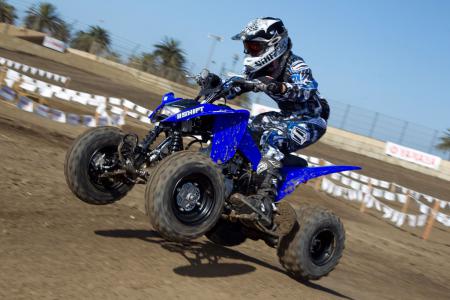 2011 Yamaha Raptor 125 |
Ever since we got word of the new 2011 Yamaha Raptor 125, we’ve been counting down the days until we got to throw a leg over the new machine. Fortunately, Yamaha answered the call by asking us to come out to the west coast to put the new Raptor through its paces.
Be sure to check out our HD video review of the Raptor 125 here.

Yamaha’s custom-built track was the perfect place to showcase the newest Raptor.
Ventura, Calif. is where we would get the chance to check out and ride the all-new Yamaha Raptor 125. Set right on the beach, Yamaha built a custom track at the Ventura Fairgrounds. This is the home of the Ventura Raceway that is known for hosting a variety of racing events, including sprint car and flat track nationals. The custom track Yamaha had prepared for us featured long sweeping corners, tight berms, a few table tops, and a whoop section. Once we got settled in at the track we got geared up and readied ourselves for a fantastic day of riding.
Right off the bat the first thing you notice is that the Raptor 125 looks fantastic. Modeled after its big brother, the Raptor 250, it is easy to see the similarities in looks. Although the 125 has slightly different styling you can definitely tell the Raptor 125 belongs to the Raptor legacy. Aggressive plastic lines are matched by a very stylish headlight. These two characteristics make the Raptor 125 look more like a full-size ATV. In addition to the standard Yamaha Team Blue color scheme Yamaha also offers a white Raptor 125 with two graphic kits to choose from; a skull and flames kit, as well as pink graphics to meet both boys and girls likings.
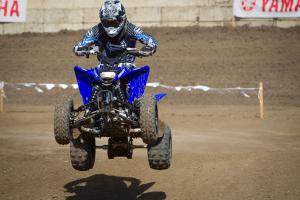
Because the Raptor 125 is so light, it’s ridiculously easy to flick around.
To our surprise the Raptor 125 has excellent power for a 125cc machine. Although it doesn’t have as much power as the 250, it will still get you around the track faster than you’d expect. Even for some of the heavier riders weighing in at over 200 lbs The Raptor 125 didn’t seem to lag in the engine department!
Some of this performance can be attributed to a 30-pound weight reduction compared to the Raptor 250. This improves the power-to-weight ratio, making for excellent acceleration and impressive handling. The Yamaha Raptor 125 shares the same engine as the Yamaha TTR125 dirt bike, but it has some modifications to make the engine better suited for an ATV. A different exhaust system, carburetor and cams are all ATV-specific.
We found the Raptor 125 to have very light steering, which was emphasized by the tight track we were ripping up. With little effort you can kick the back end loose around corners giving that feeling of riding a bigger bike. Try doing that on one of the knock off brand ATVs! Even in the air the Raptor 125 is easy to control. As you can see from some of the photos we could easily whip the Raptor 125 over even the smallest jumps.
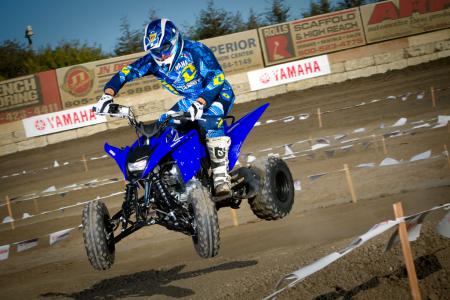 Though it’s not a powerhouse, catching a little air is no trouble for the peppy little Raptor 125. |
While out on the track we never experienced any bottoming out of the shocks. The shocks and A-arms that Yamaha chose to use were taken directly from the Raptor 250. The front five-way adjustable shocks boast 7.5" of front wheel travel that gives the rider a very plush ride. As Yamaha put it “You will run out of motor before you ever run out of suspension on this ATV.” Yamaha wanted this machine to be well suited for any weight of rider. The shocks do a very nice job soaking up bumps and they did a great job going over whooped out sections.
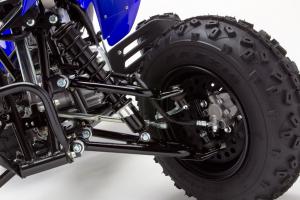
Adjustable suspension and quality Maxxis tires help keep the Raptor’s handling spot on.
Yamaha and Maxxis collaborated to come up with the tires that are fitted to the Raptor 125. Measuring 19 x 6-10 in the front and 18 x 9-8 tires in the rear these tire sizes where chosen to help improve cornering and to provide excellent traction. While riding the 125 we never had any problems with the tires not hooking up and they allowed us to break the rear end loose when we wanted to.
Over the last couple of years we have spent a lot of time on the Yamaha Raptor 250. We’ve logged many miles in the woods and countless laps on the motocross track, in addition to building up a Project Raptor 250 for an ATV.com exclusive giveaway. Needless to say we were curious to find out how the Raptor 125 would compare to its bigger brother.
Overall we feel the Raptor 125 not only does a successful job of filling the void of high quality ATVs in between 90cc and 250cc, but it also makes for a great ATV for a beginner rider. One thing we would like to see in the future is the option to choose piggyback reservoirs on the shocks like the new 2011 Raptor 250. We feel that having that option would take the littlest Raptor to the next level. It would also be an advantage to those interested in getting into racing. Classes are already in place for motocross and cross country racing and the Raptor 125 seems like it would be a natural fit for the young racer.
With its attractive price tag ($3,399), light weight and five-speed transmission, the Raptor 125 looks to us like a great introductory model to anyone wanting to get into the sport ATV world. Having the support of a major manufacturer and a vast dealer network sets this machine apart from the crowd.
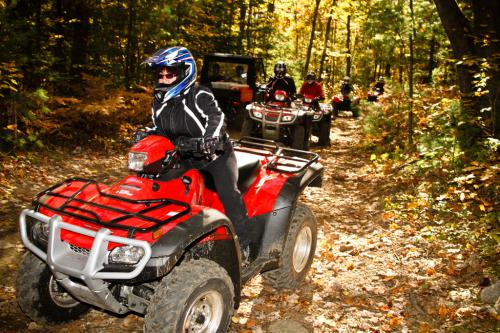
With summer a distant but fond memory, we thought it was high time to get out for a little autumn ATV adventure. As luck would have it, we had the opportunity to visit one of the most ATV-friendly areas in North America – Ontario. Specifically, we were heading to an area known as Ontario’s Near North, a region absolutely teeming with ATV trails. Using Toronto as our home base, we loaded up the car and headed to our first destination – North Bay. We began our three-hour journey by pointing the car north on Hwy. 400. It doesn’t take long at all to escape the hustle and bustle of Toronto and the changes in scenery are jarring. Gone are the crowded streets and imposing skyscrapers, replaced by lush farmland, clear lakes, vast forests and the rugged Canadian Shield. Here’s the view from our car on the way up to North Bay. The most shocking change, however, was the colors. Fall had just arrived in Toronto and the leaves on the trees were only beginning change from green to gold. However, the further north we travelled the more intense the change was. By the time we turned onto Hwy. 11 about an hour north of Toronto the landscape was a rich palette of red and gold set against a clear blue sky. This had the makings of an awesome trip. You know a restaurant is popular when it builds its own bridge to accommodate its customers.
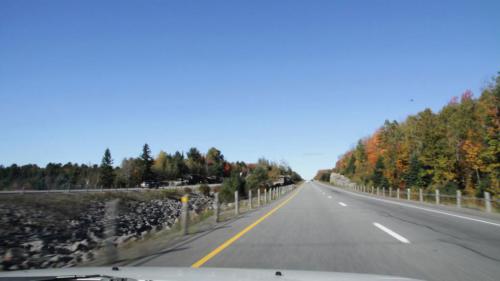

We stopped for a bite to eat about half way to North Bay, just north of Orillia at a legendary spot right on the side of the highway – Webers. Webers is an institution in this area, slinging burgers and fries since 1963. It’s so popular the owners actually had a bridge built over the highway so drivers heading north or south could stop in! After picking up our food we sat at a picnic table in the back and took in the fall colors, but an old train car is available for indoor dining.
After filling our bellies we continued the rest of the way to North Bay where we met up with the rest of our party at the Best Western North Bay. We got the keys to our rooms, relaxed and were able to check our email thanks to the free Internet connection. The indoor pool was enticing, as was the sauna and exercise facility, but we bypassed all that in favor of getting a drink at Joso’s Restaurant. The rest of the team soon joined us so we settled in for a night of fun and good food. Hotel General Manager Ruth St. Phard even joined us for a little while for a few laughs before heading off to our rooms for some shuteye before hitting the trails.
Sleep was fitful as we were as excited as a kid on Christmas to start riding. The team was gathered and we headed east on Hwy. 17 for a 30 minute drive to Mattawa, an entryway to the expansive Voyageur Multi-Use Trail System (VMUTS). We met up with some locals at Draper’s Bakery & Café for a cup of coffee and a BLT. Glen Draper is the proprietor and he also happens to be one of the driving forces behind the trail system.
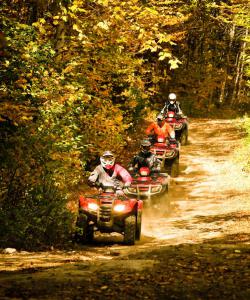
“We have 300 kilometers of well-maintained trails,” says Draper. “We’re working towards a huge market. We have 3,000 kilometers mapped with GPS coordinates and we’re going through the process right now with the conservation authorities to have them all approved.”
If you’re not sure exactly how much 3,000 kilometers is – it translates to more than 1,850 miles. That’s more than a 100 miles longer than distance between Chicago and Los Angeles and it’s all available to be ridden by anybody right now! We were absolutely blown away to hear this and thrilled to start our two-day ATV journey.
Parked behind Draper’s was a fleet of brand new Honda ATVs just begging to be ridden, provided by Honda Canada. Honda is a huge supporter of VMUTS and Draper was rightfully singing its praises.
“We’re very fortunate with organizations like Honda because without the support of these manufacturers, organizations like ours…we can’t exist,” says Draper. “How do we get volunteers on the trails? Most of the people that have their own ATVs want to go ride. The carrot is what Honda has recognized is loaning us those ATVs to have a safe maintained trail. Now we can say ‘we’ve got a nice ATV for you to ride, will you come and help us?’ And they jump on the opportunity.”
We excitedly jumped on our Hondas and rode right through town until we hit the trails. It should be mentioned that the town of Mattawa is exceedingly ATV friendly, allowing ATVers to ride on public roads so long as they use proper hand signals and follow the rules of the road. Even local restaurants and accommodations welcome ATV riders with open arms. As Mattawa Voyageur Country Tourism Development Co-ordinator Mike Stiell tells us, it’s not uncommon to see a half dozen ATVs parked in front of a local restaurant. Well-constructed bridges help connect the trails and protect all the local waterways.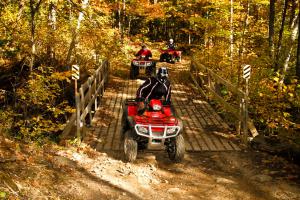
It didn’t take long after hopping aboard the Hondas that we hit the trailhead and the real fun began. We were welcomed by a canopy of trees that were raining down multi-colored leaves. It smelled just like you’d expect it to – earthy and fresh. We played around all morning, darting here and there on wide-open trails. Because we were riding on a Monday the trails were almost empty. We only saw a couple of ATVs and a few hikers all day long, but you can expect to run across more people on the weekend or during peak summer weeks.
Besides the seemingly infinite trails at our disposal, most impressive was how well maintained everything was. Northern Ontario is home to hundreds of lakes and rivers and all the water crossings on this trail system featured a sturdy, honest-to-goodness bridge. That may not sound like a big deal, but we’ve seen so many hastily-built bridges over the years that we’ve come to appreciate quality when we see it.
We were fortunate to have a guide with us, but the trail system is so well marked with easy-to-find signage that it would have been pretty simple to find our own way. Our goal for the first day was to reach a lookout that we were told provided an incredible view. We were not disappointed. The lookout is basically a large wooden deck built on one of the higher points of the trail system. The view it provides is breathtaking – especially in the fall. You’re treated to a kaleidoscope of colors as the trees amble down to the valley below.
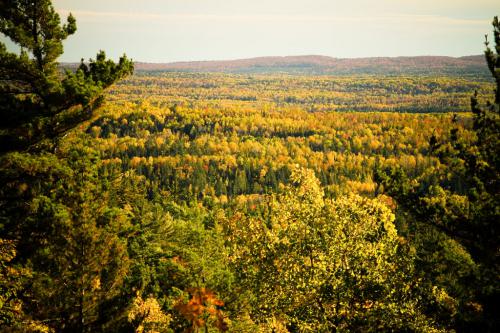 This view was well worth the effort it took to reach the lookout. |
Of course, the VMUTS is about far more than the views. ATVers are lavished with a varied system of trails that has something to offer for just about anybody. Wide-open areas for high-speed riding; tight tree-lined and rock-strewn paths with sharp turns; steep climbs and descents that will test your nerves; even deep and silty sand washes. We found all that and more within 20 miles. Who knows what else we’d find if we had time to explore everything.
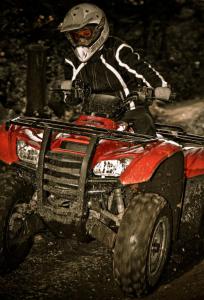 It was easy to find places to get a little dirty. | 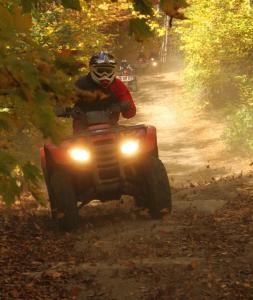 Wide and varied trails for high-speed fun were also in abundance. |
After logging some serious miles the first day we headed off to the beautiful Moosehead Estate and Retreat for some much-needed nourishment. Located on the shore of Lake Champlain, this history-rich century home serves as a restaurant and bed and breakfast and was the perfect place to wrap up our first day on the trails. Following dinner we checked in to our rooms at the Valois’ Restaurant and Motel for some hard-earned sleep.
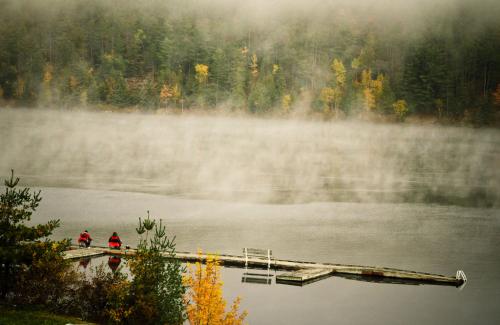
Two fishermen were casting their lines as the morning fog lifted off the Ottawa River.
Because Mattawa is low lying and surrounded by the Algonquin Highlands and Laurentian Mountains, the town is covered by a foggy mist in the early mornings. When it starts to break up and the Ottawa River reveals itself it’s a sight to behold. That’s the view we got to take in as we enjoyed an early breakfast. It’s hard to start a day any better than that.
The goal for the second day was to reach the mica mine for a little subterranean exploration. However, we had plenty of trails to investigate before got there. We were feeling a little more comfortable on the second day and the speeds started to increase as we tested the limits of our ATVs and our resolves. Bouncing over rocks and other trail debris while leaving a wake of fallen leaves was a top priority and it brought no shortage of smiles to our faces. Spend a day like this and life feels very good indeed.
On the way to the mica mine we took a short detour to check out a gorgeous lake that is connected to the trail system. A camping area is located right off the trail, but the lake was deserted and offered us a perfect place to enjoy lunch, which was provided by Draper’s Bakery & Café. We were tempted to jump in for a swim, but Ontario lakes can be pretty chilly in October so instead we fired up the ATVs again and continued on our journey.
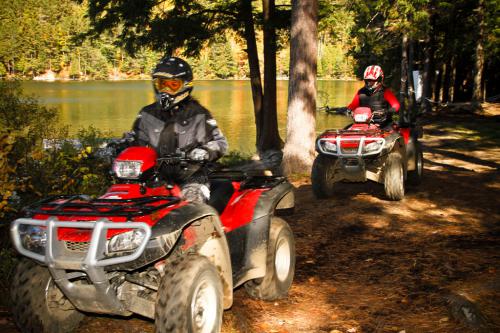 We found one ATV trail that led us to this beautiful and largely uninhabited lake. |
As expected, the trail led directly to the mica mine. Everybody unloaded, grabbed a flashlight and headed underground. Abandoned mines are generally a little creepy and this one was no exception – helped no doubt by the hundreds of bats we saw dangling from the rocks. Still, it was fun to poke around and explore, but before long the ATVs were calling our names and it was time to head for home.
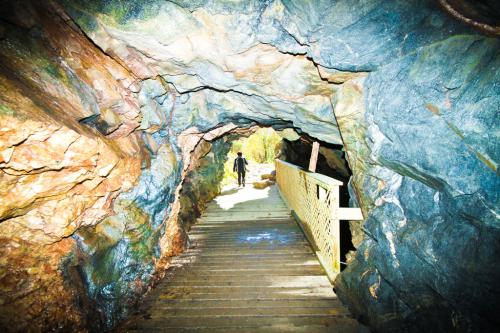 Here’s the entrance to the mica mine. Make sure you bring a good flashlight before you go exploring. |
Our trip back to town was loads of fun. We had all the pictures we needed by then so we just played around and soaked it all in before we had to leave. Like school kids during the final days of summer vacation, the end was near but it was awfully hard to let go. You can bet we'll be back to see even more of the fantastic Voyageur Multi-Use Trail System.
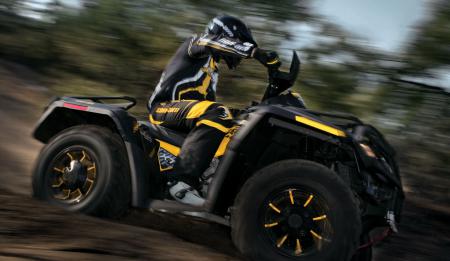
Style starts from the ground up on the Can-Am with the cast aluminum rims and yellow plastic inlays contrasting the deep black fascia that make the machine look sharp. This coloring choice compliments the aggressive looking racking and body moldings.
The XT-P has a bold graphics package of yellow and black that wraps the gas tank and runs up the mud flaps. The combination of matte and shiny black plastics give the XT-P dynamic lines. Despite the work on the styling this ATV wasn’t only designed for looks, it was built with performance in mind.
Powering the XT-P is the Rotax V-Twin 799.9 cc EFI engine. Can-am claims that this is the most powerful 800cc motor in the industry, churning out a claimed 71 hp. On a back road in Northern Ontario we got a chance to see just what 800cc of raw power felt like. We punched the throttle wide open and when the speedometer read 58 mph we had a distinct “Holy-crap” moment.
When you squeeze the throttle on the Outlander 800R you’d better be prepared to hang on tight. |
After the speed run we started to evaluate the machine’s ability to accelerate and decelerate. Putting a lid on all this power is Can-Am’s progressive throttle setup. This system helps to manage the power at low speeds and keep it controlled when wide open. As expected this engine provides a huge amount of torque, but it is kept manageable thanks to this system. It allowed us to pick our way through rocks and rough sections without the fear of engaging too much power and losing control.
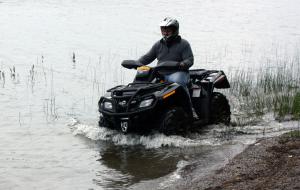
Helping add to this sense of security in handling are the ergonomics of the Outlander that aide in keeping the machine under control while on your ride. The riding position on the XT-P is very comfortable and allows you to move from a sitting to standing position quickly.
The Outlander’s SST chassis was designed with relaxed cruising and aggressive trail riding in mind. This frame gives the machine a very nimble and confident feel on the trails thanks in part to its overall dry weight of 669 pounds. Navigating the tight portions of the forest trails was simple too.
One interesting feature on the frame we noticed when the machine was still on the trailer was that all the wheels feature independent brush guards protecting the drive shaft housings and workings. After splitting several CV joint boots on various models last season we all felt that this is an excellent addition to under-belly protection.
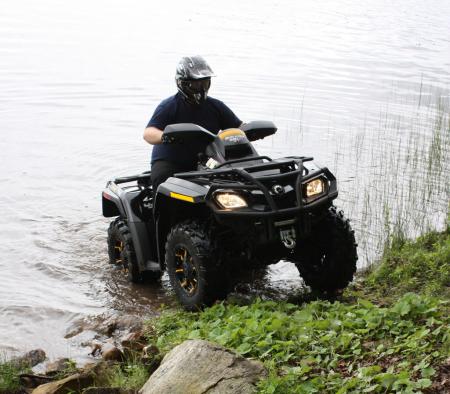 Brush guards on all four wheels help protect the Outlander from rocks and debris |
In addition to the guards the Outlander’s ground clearance is 12 inches, which allows ample room to clear obstacles that could damage your machine’s under-carriage. This height also helps you to get in and out of steep approaches such as hills, river banks, and over low obstacles like stumps and rocks.
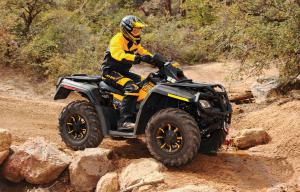
Stock suspension settings are fairly stiff, but the shocks can be tuned to suit your riding needs.
Helping the bike sit up so high off the ground is its ample suspension setup. The front double A-arm setup allows for eight inches of travel and the TTi rear independent suspension allows for nine inches of travel.
At speed or when running slow we found the suspension was still fairly stiff. This is great for riders who are looking for an aggressive trail experience but not so great for anybody looking for a comfortable trail ride.
You can tune down the rebound and pre-set on the shocks, but we found this made the ride far too washy in the corners to be enjoyable as well. It can be a fickle balance to find the setting which is just right for you on the XT-P.
Tuning up the shocks was simple as well and required few or no tools. The tools we did require were located in the rear storage compartment and were easily accessible. The front and rear compartments are held down with rubber fasteners and are water proof which makes them perfect for storing and easily accessing gear on the trail. I had a couple of items stowed for my ride including some trail maps, extra gloves, a sandwich and water bottle, a tow strap, and extra goggles. Nothing got wet and nothing got dirty – perfect.
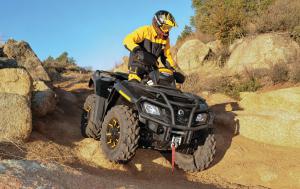
When in place the storage covers can still have gear strapped down on them so they don’t take away from the usefulness of the front or rear racks. The rider can place about 100 pounds of gear on the front while the rear supports 200 pounds. Plenty of tie-down points and hooks make securing your gear simple. The only problem with this is that when you have anything strapped down you can’t access the storage compartments without removing your gear first. Don’t store anything you need to get to frequently on the trail if you have a lot of gear on your racks. I had to remove a gear bag I had strapped down to get access to my maps, which was a bit annoying.
Up top on the handlebar the rider has all the controls easily accessible at their fingertips and the large print digital readout makes monitoring engine performance simple. The shifter is located on the side of the gas tank and allows the rider to select between high, low, neutral, reverse and park on the XT-P’s CVT transmission.
The transmission features a strong engine braking system that seemed almost too strong at times. The XT-P seemed to be either accelerating or instantly decelerating with no rolling or lag time in between. This meant that during our ride you had to either be on the throttle constantly or you’d slow down and hold up the group behind you.
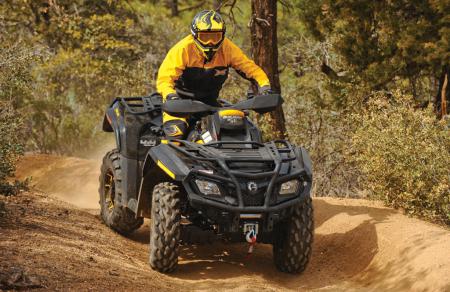 We found the engine braking to be effective, but maybe a little too strong. |
Parking our Outlander XT-P outside for the overnight portion of our ride left us with the normal worries of potential theft. Along with our standard “padlock and chain” method of security the console of the machine is programmed with BRP’s Digital Encoded Security System (D.E.S.S.). This system will lock out the engine if someone attempts to start it without the encoded key.
An improved 650-watt magneto allows for a 12-V output mounted on the body just below the handlebar. This allows you to plug in any typically “car-style” accessories. On our ride we had chargers for phones and even had a GPS unit running on one of the units.
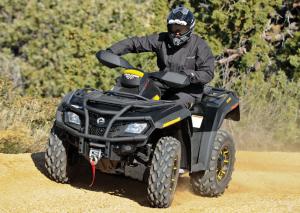
The factory-installed winch has a 3,000-pound capacity that should be able to get you out of a jam.
Other features on the handlebar include selectable 2WD or 4WD shaft driven Visco-lok Front differential. The Visco-lok system allows the machine to quickly engage more or less power to a wheel when it’s required. This is a benefit when riding in terrain with constant ups and downs such as rock crawling or slippery conditions like mud and rain.
The XT-P comes equipped with a BRP XL3000 winch. This winch is factory installed and has a pulling capacity of 3,000 pounds. We never really got a chance to use this winch (because we couldn’t get stuck!) but the controls are located on the handlebar as well as on a remote which is connected through a cord. This is a nice feature as someone else (up to five feet away) can operate the winch while the rider continues to work the machine out of whatever you’ve gotten into.
Another feature which helps to compensate for terrain is the XT-P’s dual mode power steering unit. This allows the rider to select either a maximum output or minimum setting. We played around with the two settings over the time we had with the machine a fair bit. Some of the other test riders left it on MAX the whole time and commented that they loved it that way. I found that I only had it on MAX while doing slow speed maneuvers and while towing a trailer.
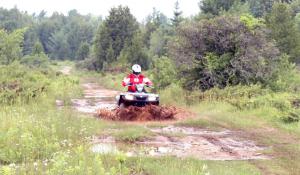
Just to get a really good feel for the towing capability of this machine we used it to move around some equipment. Low end torque on the Outlander 800R is powerful enough to pull nearly any load you can put on it but the factory recommends that you only tow up to 1,300 pounds.
When we weren’t hauling a trailer we used the minimum power steering setting for traveling at speed because we found that the MAX provided the potential for over-steering in a situation where you wanted minimal output. The unit does decrease the output exponentially based on speed but we still felt that it was a little more than needed.
Also designed for traveling at speed are the machine’s handlebar-mounted wind deflectors. These are very nice at high speed for keeping your hands warm and also in the forest for protecting your hands from branches or other obstacles.
The overall feel in the saddle of this machine is confidence. The power is sufficient for any situation and the suspension and frame setup make riding either gently or aggressively comfortable. The XT-P will do or go wherever you want it too, and it’ll look good doing it. Those sweet looks and performance extras do cost, however. The Outlander 800R XT-P retails for $11,249, which is a whopping $2,000 more than the base Outlander 800R.